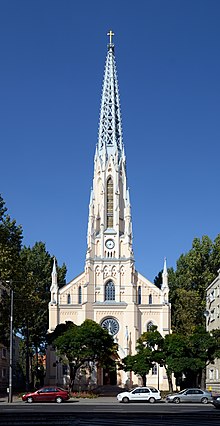Evangelical Reformed Parish in Warsaw
| Evangelical Reformed Parish in Warsaw Parafia Ewangelicko-Reformowana w Warszawie (Polish) |
|
|---|---|

The church of the Evangelical Reformed Parish in Warsaw.
|
|
| 52°14′38″N 20°59′54″E / 52.2440°N 20.9983°ECoordinates: 52°14′38″N 20°59′54″E / 52.2440°N 20.9983°E | |
| Location | Warsaw |
| Country | Poland |
| Denomination | Polish Reformed Church |
| Website | http://reformowani.org.pl/ |
| Architecture | |
| Architect(s) | Adolf Loewe |
| Style | Gothic |
| Groundbreaking | 1866-10-30 |
| Completed | 1880-10-24 |
| Clergy | |
| Pastor(s) | Michał Jabłoński |
Evangelical Reformed Parish in Warsaw (Polish: in full, Parafia Ewangelicko-Reformowana w Warszawie) is a Polish Reformed church in Warsaw at Aleja Solidarności 76a.
The parish was registered in Leszno in 1776, when a decree from 1525, banning dissenters settling in Mazovia, was withdrawn. A year later, the first Reform church (now the headquarters of the Warsaw Chamber Opera) and the rectory was built and designed by Szymon Bogumił Zug.
On October 30, 1866, the construction began of a new church in the Gothic style, designed by architect Adolf Loewe. Construction lasted 14 years and on October 24, 1880, the church was dedicated. A high tower with a shawl helmet is modelled on the tower of The Cathedral of Our Lady in Freiburg im Breisgau. Among the elements that draw attention are the oak pulpit made and designed by .
In 1881 the parish founded in the Działyński Palace included a hospital, an elementary school, a home for orphans, and a nursing home.
After regaining independence, parish life began to evolve rapidly. This resulted in a Youth Association, a Mission Inner Circle and a Ladies Auxiliary and they conducted Sunday school classes. Trips outside the city were organised as well as camps for children in property donated to the church.
In this time there were two parish magazines. Between 1924 and 1928 "Żagiew Chrystusowa” (The Torch of Christ), and from 1926 to 1939 "Jednota” ("Unity").
In 1940 the buildings of the parish including the church, Działyński Palace, the hospital and several other buildings in the so-called "Evangelical enclave" near the Warsaw ghetto area were destroyed during the defence of Warsaw in September 1939. Parishioners and clergy helped save Jews from the ghetto, which is commemorated by one of the monuments on the boundaries of the ghetto, located behind the parish.
During the occupation, many parishioners were killed, and several priests murdered. Evangelicals also took part in the Warsaw Uprising.
...
Wikipedia
